Klediments:
*** How much of art making is a way of claiming power over the imaginations of those who serve, over those who rule, over the gods of nature, and even over death. This is one of the great temptations of artists and one that ought to be continually examined. Of course death will end the artist’s will to power but does it break their hold on simulacra and illusion? I wonder if the will to power and the denial of death are not to some degree behind every image we make, even the simplest snap-shot taken with our phone cameras and then instantly messaged or posted on Facebook. How much of our ‘on-line‘ presence isn’t just a kind of digital embalming of our false selves?
Of course, we might ask the same thing about language. One of the great iconoclastic interlocutors of Saint John of Damascus’ (an ardent iconodule) argued against the use of icons writing that, ‘...images enter the mind unimpeded by reason.‘ He also argued (I write “He” because his name is lost to history, as we say. That is, he was killed and most of his writings were burned by the church) that it might be possible to allow some limited use of icons within the confines of a church building where the images could be carefully administered and constricted by language and doctrine. Saint Johnny D rebutted the iconoclasts by writing that if the human nature of christ is unrepresentable then isn’t language about Jesus also idolatry? For many Orthodox icons are often given a similar authority as the bible and engaged as another expression in which divine and human forms and actions become blended. In any event, like most important theological issues, the real arguments about icons in the 6th to 8th c. and later on in England and Europe had much more to do with the control and distribution of power and resources, control of trade routes, access to raw materials, etc., than it did with semiotics or any obtuse doctrines about the hypostatic union or analogia entis.
*** “Man is created in the image of God and God’s image cannot be captured by any human machine. Only the divine artist divinely inspired, may be allowed, in a moment of solemnity at the higher call of his genius, to dare to reproduce the divine-human features, but never by means of a mechanical aid! Here, in all its ponderous vulgarity, treads forth the philistine notion of art, dismissive of every technical consideration yet, sensing its doom as the new technology makes its provocative entry. Nevertheless, it is this fetishistic, fundamentally anti-technical notion of Art which theorists of photography have tussled for almost a century without, of course, achieving the slightest result.” (Walter Benjamin- A Short History of Photography).
*** When the first human drew a circle on a cave wall and named it the sun, that cave became a church and the artist became a priest, and then the hunters feared her because she took for herself some of their power. And so the warriors came to her before every hunt and battle to bless them and to give them strength and take away their fear. She drew pictures of the hunters on the stone walls for them, and then she drew a great beast with a spear through it’s heart. After that she drew a roaring fire in ochres and reds that so amazed the people that they were afraid to touch it lest it burn them. And around the fire she drew all the people dancing and feasting, and so the hearts of the hunters were filled with courage and the minds of the people were at peace.
But when a beast escaped, or hunters were killed and the people went hungry or they were attacked by other tribes it was then that the priest proved just how much power she really wielded. For In this world of constant threats and dangers where humans are just one among many small, naked, and vulnerable animals whose survival rests on innumerable contingencies and unknown dangers over which they have limited control, fear rules all emotions, life-ways, and affections. But that same fear that compels vulnerable humans to live together in familial and interdependent communities also constantly threatens any forms of common life and mutual sacrifice; and so the people must continually make supplications for life to the gods of earth, water, fire, and sky. Sometimes with words. Sometimes with blood.
Whenever there was too much rain or not enough and the rivers flooded or ran dry, or when the migrating herds failed to arrive as expected, or when the ice and snow came earlier and lingered longer each year, or when the people’s enemies grew in numbers and boldness, then the priest would venture alone into the cave with only her instruments of charcoal made from fire and wood, and pigments distilled from earth, rock, and sacred flora. It was only she who would dare to speak to the gods for her people, to stand in their place, to re-present them, to beg or to barter for life. And if the priest could assuage their anger or stir them from their indifference or even arouse their pity, then the gods might choose to guide the priest’s hands as she translated and inscribed onto the cave’s walls what they would require to give the people victory over their enemies, success with the hunt, rain in season, and children that survived.
The people would kneel and wait at the mouth of the cavern where they witnessed shadows and light wrestling inside the dark hole. They could hear the echoes of the moans and cries of the priest, but they also heard other voices and unknown tongues sometimes whispering, sometimes howling in rage and anger. And when the priest emerged form the cave her bloody body was covered with indecipherable markings, colored lines and intricate glyphs, signs that the gods had spoken with her and through her. She then gathered the people into a circle around her and led them in chant as she leaped and twirled choreographing (dance-writing) the messages from the invisible other-world that surrounds all. The people were astonished and joining her they chanted and danced until all fear was exorcized from their hearts and so the people were awed and her power increased.
*** Hebrews 1 v. 3, “Jesus is the radiance of the glory of God and the exact imprint of his nature, and he upholds the universe by the word of his power. After making purification for sins, he sat down at the right hand of the Majesty on high.
 |
| Acrylic on plaster. 2002 30X42 in. |
God bless and much obliged.




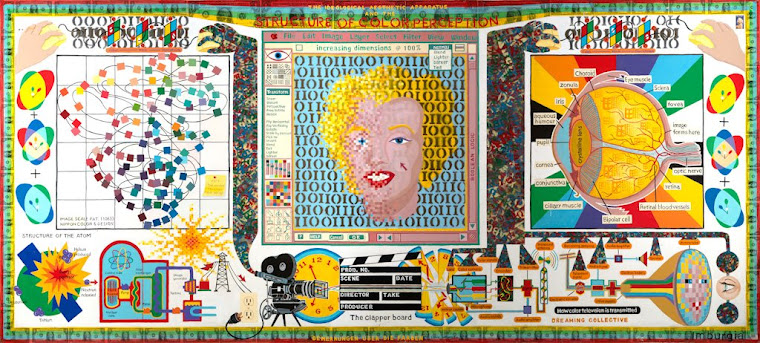


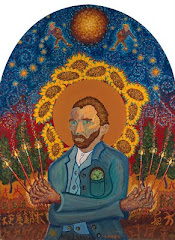


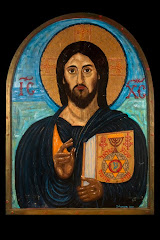
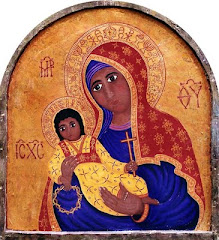

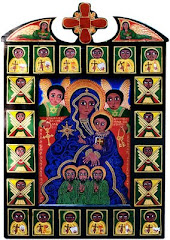

No comments:
Post a Comment